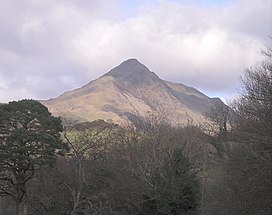| Cnicht | |
|---|---|
 Cnicht from the south-west | |
| Highest point | |
| Elevation | 691 m (2,267 ft) |
| Prominence | 105 m (344 ft) |
| Listing | HuMP, Hewitt, Nuttall |
| Naming | |
| English translation | knight |
| Language of name | Welsh |
| Pronunciation | Welsh pronunciation: [ˈknɪχt] |
| Geography | |
| Location | Gwynedd, Wales |
| Parent range | Moelwynion |
| OS grid | SH645466 |
| Topo map | OS Landranger 115 |
| Name | Grid ref | Height | Status |
|---|---|---|---|
| Cnicht | 689 m (2,260 ft) | Nuttall |
Cnicht is a mountain in Snowdonia which forms part of the Moelwynion mountain range. [1] [2] [3]
Its appearance when viewed from the south-west, i.e., from the direction of Porthmadog, has earned it the sobriquet the " Matterhorn of Wales", albeit being 3,789 metres lower. In reality, Cnicht is a long ridge and, at 691 m, is the fifth-highest peak in the Moelwynion mountain range. It can be easily ascended from Croesor, the village at its foot, or, with more difficulty, from Nant Gwynant to the northwest.
Although regarded by some as a mountain in its own right, Cnicht does not have the required 150m of topographic prominence to be classed as a Marilyn.
The mountain's name is thought to derive from the English surname Knight, the name of a family who were formerly merchants in Caernarfon. When borrowed into Welsh, the consonants represented by ⟨K⟩ and ⟨gh⟩ were still[ when?] pronounced in English, and these are retained in the Welsh name Cnicht as ⟨C⟩ (/k/) and ⟨ch⟩ (/χ/). [4]
It appears as the "Saeth" in Patrick O'Brian's 1952 novel Three Bear Witness (published as Testimonies in the USA), which is set in a fictionalised version of Cwm Croesor. [5] O'Brian and his wife lived in the valley between 1946 and 1949.
- ^ Marsh, Terry. The Summits of Snowdonia (London: Robert Hale, 1984)
- ^ Marsh, Terry. The Mountains of Wales (London: Hodder and Stoughton, 1985)
- ^ Nuttall, John & Anne (1999). The Mountains of England & Wales - Volume 1: Wales (2nd edition ed.). Milnthorpe, Cumbria: Cicerone. ISBN 1-85284-304-7.
- ^ Owen, Hywel Wyn and Richard Morgan, Dictionary of the Place-Names of Wales (Llandysul: Gomer, 2007), p. 91.
- ^ Tolstoy, Nikolai (2005). Patrick O'Brian: The making of the novelist. London: Arrow. pp. 337–339. ISBN 0-09-941584-4.
53°0′1.26″N 4°1′7.66″W / 53.0003500°N 4.0187944°W
| Cnicht | |
|---|---|
 Cnicht from the south-west | |
| Highest point | |
| Elevation | 691 m (2,267 ft) |
| Prominence | 105 m (344 ft) |
| Listing | HuMP, Hewitt, Nuttall |
| Naming | |
| English translation | knight |
| Language of name | Welsh |
| Pronunciation | Welsh pronunciation: [ˈknɪχt] |
| Geography | |
| Location | Gwynedd, Wales |
| Parent range | Moelwynion |
| OS grid | SH645466 |
| Topo map | OS Landranger 115 |
| Name | Grid ref | Height | Status |
|---|---|---|---|
| Cnicht | 689 m (2,260 ft) | Nuttall |
Cnicht is a mountain in Snowdonia which forms part of the Moelwynion mountain range. [1] [2] [3]
Its appearance when viewed from the south-west, i.e., from the direction of Porthmadog, has earned it the sobriquet the " Matterhorn of Wales", albeit being 3,789 metres lower. In reality, Cnicht is a long ridge and, at 691 m, is the fifth-highest peak in the Moelwynion mountain range. It can be easily ascended from Croesor, the village at its foot, or, with more difficulty, from Nant Gwynant to the northwest.
Although regarded by some as a mountain in its own right, Cnicht does not have the required 150m of topographic prominence to be classed as a Marilyn.
The mountain's name is thought to derive from the English surname Knight, the name of a family who were formerly merchants in Caernarfon. When borrowed into Welsh, the consonants represented by ⟨K⟩ and ⟨gh⟩ were still[ when?] pronounced in English, and these are retained in the Welsh name Cnicht as ⟨C⟩ (/k/) and ⟨ch⟩ (/χ/). [4]
It appears as the "Saeth" in Patrick O'Brian's 1952 novel Three Bear Witness (published as Testimonies in the USA), which is set in a fictionalised version of Cwm Croesor. [5] O'Brian and his wife lived in the valley between 1946 and 1949.
- ^ Marsh, Terry. The Summits of Snowdonia (London: Robert Hale, 1984)
- ^ Marsh, Terry. The Mountains of Wales (London: Hodder and Stoughton, 1985)
- ^ Nuttall, John & Anne (1999). The Mountains of England & Wales - Volume 1: Wales (2nd edition ed.). Milnthorpe, Cumbria: Cicerone. ISBN 1-85284-304-7.
- ^ Owen, Hywel Wyn and Richard Morgan, Dictionary of the Place-Names of Wales (Llandysul: Gomer, 2007), p. 91.
- ^ Tolstoy, Nikolai (2005). Patrick O'Brian: The making of the novelist. London: Arrow. pp. 337–339. ISBN 0-09-941584-4.
53°0′1.26″N 4°1′7.66″W / 53.0003500°N 4.0187944°W